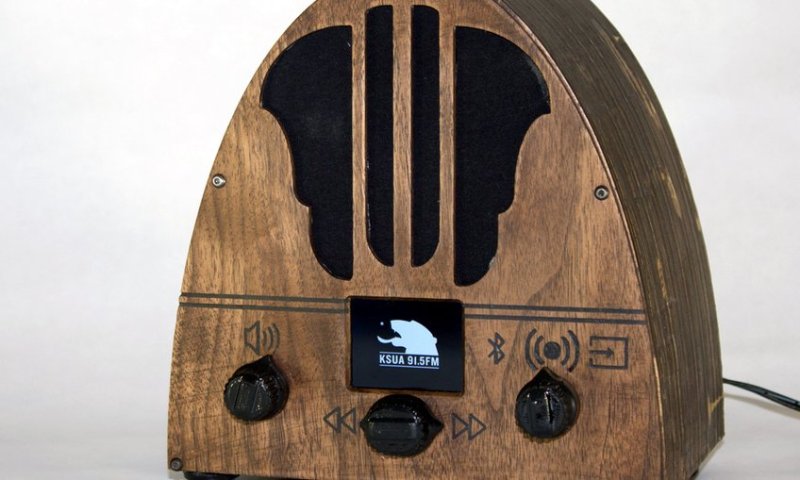If you’re looking for a hot collectible item and a great restoration project, cathedral-style radios from the 1930s are a solid choice. But they’re getting harder to find as the years roll by, so if your heart’s content is to listen to modern broadcasts through a radio with a classic look, you may need to roll your own cathedral case for an internet radio.
The cathedral-style case was a hugely successful form-factor for radios back in the day, with variations on the arch-top theme ranging from Gothic to Art Deco. For this build, [nick.r.brewer] decided on a more parabolic arch. His build log has SVG files for the individual ribs that were cut from plywood with an X-Carve. A Raspberry Pi and TFT display were mounted inside the finished case, along with a Bluetooth module and a 20W amplifier and speaker. A big 3-pole rotary switch with custom knob selects the audio source and evokes that 1930s feel. It ended up looking pretty good, and the video after the break shows that it sounds nice, too.
We featured a fair number of internet-radio-in-a-classic-case builds before, but we’re surprised to see no cathedral-style radios have been modded. Maybe it’s time to hit the flea market and estate sales and see what turns up.

The Raspberry Pi Zero contest is presented by Hackaday and Adafruit. Prizes include Raspberry Pi Zeros from Adafruit and gift cards to The Hackaday Store!
See All the Entries || Enter Your Project Now!















I think I would go for a better finish than the found-in-a-damp-basement look, but a nice project just the same.
I would have glued the front on and only used screws on the back panel. Steam bent veneer on the sides would have made a cleaner finish.
I really like that no antique radios were harmed. This does make you appreciate the craftsmanship that went into those old radios.
Nice project. Thanks for sharing!
Ditto for no screws on the front. If there is bass, there isn’t enough screws now to stop buzzing.
I can almost hear the soothing rich voice of Jim Svedja on KUSC. An antidote to all of the Fred Child school public radio announcing.
Need two for stereo.
My wife has a cathedral style clone from the 70s, it has a great mellow sound with the original radio, especially on AM. I’d be keen to keep that part working, and just add a Raspberry Pi with Wi-Fi and BT for modern radio. I’d have to figure out how to control it without damaging the look of the radio face; maybe controls and a small screen on the back or side.
Hidden reed switches and a magic/magnetic wand?
Considering the amount of work that went into the case, I’d have gone a little further for no screws in the front and something better than “marked up with a sharpie” for the control labels. While it’s somewhat evocative of the era it simply doesn’t quite resemble a real product of the era. My ca. 1928 American Bosch classic doesn’t even have labels for the volume and tuning controls, but the brand name is gold-leafed. Laser etching would probably be an acceptable alternative, and easy if the panels were laser cut. (How WERE they made? The build page doesn’t say.)
On second look I am realizing the labels might be laser etched, in which case the unpolished wood is a very poor choice of material for that kind of presentation. You want your laser etching on something that gives sharper contrast.
In other raspi news: FCC documents reveal a Raspberry Pi3 with WiFi and BT-LE on board.(Espressif ESP8266 Wi-Fi chipset?) pcworld reports.
Oh nice object, very cool. Could you make the screen rounded by framing it then distort the graphics a bit? Like this little gem, http://antiqueradio.org/art/NationalTV-7W01.jpg
I’ve wondered for a while if the demented would be comforted by radios and TVs that seemed to tune into the era when they were young. Getting the look of the case would be very important and this project is definitely on the right track.
I’ve been looking for a cathedral radio case for more than a few years to build a guitar amp into. I can never seem to find one available at a reasonable enough price point. I would not sacrifice one that has a repairable circuit in it though. Maybe I’ll just have to recreate a case, although I’m not that skilled a woodworker.
Buy som knobs, preferebly white ones and it would look MUCH better.
Although I can appriciate the hacking side of 3D printing them, the finish leavs a lot to be desired.
Very nice work indeed.
“I really wanted an internet radio that I could program in radio stations I love from around the world (KSUA, WNYC, WFMU, etc)”. My view: “the world” is not only radiostations starting with K or W.
Too many people here complaining about the screws in the front and how it doesnt look right, etc. It is what it is.
If you want a cathedral radio you’re going to be running out of luck as most people that own them have restored them or they’re so far gone you’d need a lot of time on your hands to refinish them.
The alternative is to build a replica (which this is not attempting to be).
IMO this looks good but I was just a little surprised at the small size.